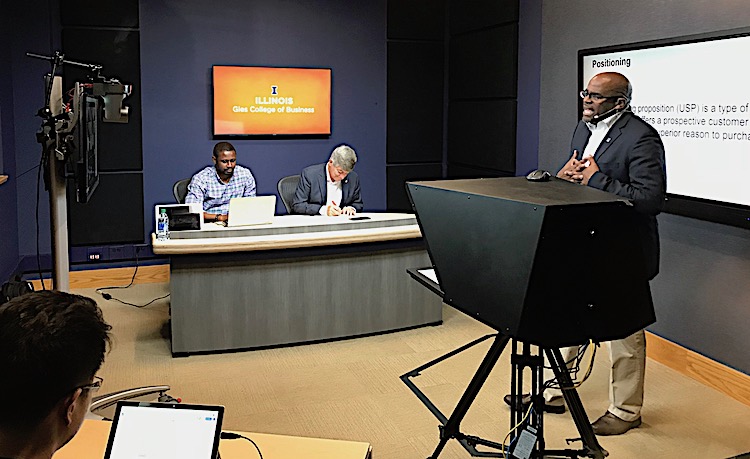
Hayden Noel in one of the iMBA studios teaching in his marketing course
GIES SAYS STUDENT SATISFACTION RATES HIGH DESPITE LARGE CLASS SIZES
Even though the size of some of the school’s live online classes can approach 500 students or more, satisfaction rates are high. Some 95% of the students say they are very or highly satisfied with the program, according to Gies, and 94% would recommend the program to others. And while students pay as they go through the program, which can take as little as two years to complete or could be stretched out to three, Gies says the retention rate for iMBA students exceeds 90%.
The makeup of the school’s iMBA students is dramatically different from the much smaller full-time MBAs cohorts the school would typically enroll in a program it has decided to shut down. Students average 11 years of work experience, hail from 47 states and 90 countries. About 20% of the students are from outside the U.S., from such far-flung locales as Saudi Arabia, Australia, India, and China. One in four of the online MBA students resides in Illinois.
Just about all the enrolled students are already employed so the program allows Gies not to make heavy investments in career services. Some 70% of the students want to stay within their current functions and industries and want to accelerate their career progress, says Arshad Saiyed, assistant dean of online learning. Another 10% are looking to improve their performance in their current roles, while only 20% hope to leverage their MBA to do a career switch. “It’s an older, more experienced crowd composed more of skill builders than career switchers,” adds Brown, “but we’ve already seen some of our students hire other students. It’s the ultimate networking opportunity.”
‘WE COULD GET UP TO 3,000 OR 5,000 iMBA STUDENTS OR THE WORLD’S POPULATION’
The fast growth in the school’s online program is partly the result of a $150 million naming gift made two years ago by Larry Gies, a successful Chicago entrepreneur who earned his undergraduate degree in accounting from the University of Illinois in 1988. While the college decided to shut down both its full- and part-time MBA programs, the school has moved aggressively to expand its footprint in the online MBA space, increase undergraduate scholarships by 50% to nearly $3 million a year, pay for a vastly expanded branding and marketing initiative, and recruit 22 new faculty this past year alone, including a highly sought-after rookie scholar in finance who had offers from Harvard, London Business School and UCLA.
Though Brown declines to disclose the school’s investment in its iMBA program, the millions he has poured into it has fueled explosive growth. While iMBA enrollment has jumped to more than 2,500 students, there’s also another 250 non-degree students taking iMBA courses, and 350 more graduate students enrolled in Gies’ master’s of accounting online. Another 1,500 University of Illinois undergraduates are taking a minor in business from Gies online.
Brown won’t provide any concrete clues about his iMBA enrollment goals, maintaining that growth is dependent on the quality of the applicant pool. The acceptance rate for iMBA candidates is 48%. The program is now cash positive, he says, though the school is a long way from recouping its investment. “We could get up to 3,000 or 5,000 steady state or the world’s population,” he coyly says. “It’s all dependent on quality. We don’t need to grow. It’s already financially viable.”
‘HAVING SMART COMPETITION IS GOOD. IT WILL KEEP US ON OUR TOES’

Gies College of Business Dean Jeffrey Brown
He’s also not worried about the recent announcement from Boston University to create an equally disruptive $24,000 online MBA that will launch next fall on edX’s platform. “Having smart competition is good,” says Brown with confidence. “It will keep us on our toes, and it lends credibility to the delivery model. My plan is always to be better than they can be. We know how much intellectual and financial investment is needed to do this.”
With Gies’ financial support, Brown has built a formidable machine, with an online learning team populated by seven full-time video producers, three full-time live studio engineers, two full-time graphic designers, 30 course assistants, eight full-time instructional designers, a full-time user experience staffer, and a full-time live session coordinator. Another 14 students are on call to do general upkeep. Yet that team doesn’t include Norma Scagnoli, senior director of eLearning, or John Tubbs, director of digital media. Nor does it include Saiyed, assistant dean of online programs, or anyone of the more than 30 faculty members who now teach online.
In any given week, the crew is producing 30 live Internet classes weekly and untold numbers of video productions for new online elective courses in five different studios at the business school.
THE FIRST ‘STACKABLE’ MBA
When the school first announced the iMBA in the spring of 2015, it touted the program as the first “stackable” MBA, meaning that a student can enter the program at any time and eventually build it into an MBA if he/she wants, stop at just a certificate, or just leave it at one course.
That early strategic decision has paid off. Roughly a quarter to 30% of the learners who first took a course without credit has gone the degree path by taking a course of a certificate for credit. And 80% of students who take courses for credit have shown intent that they want to get the MBA degree, says Saiyed.
The stackable format has also allowed Gies to create a different admissions pathway into the iMBA program. If a learner does well, posting a 3.0 or better in three for-credit courses, the student could be admitted to the program without the need to formally apply.
‘WE ASKED OURSELVES, HOW DO WE DO SOMETHING THAT WOULD GET THE WORLD’S ATTENTION?’
“The early conversations were about the mission and the goals we could achieve. It didn’t take a genius to look around and realize that MBA programs have become really expensive. So from the beginning, the desire was to smash through the business model. We asked ourselves, ‘How do we do something that would get the world’s attention?’”
When it was suggested that the school start slowly with a specialized master’s program instead of the MBA, the task force studying the initiative strongly disagreed. “At that moment, we had the chance to do something that Harvard, Wharton or Kellogg couldn’t do,” reasons Brown. “By putting the MBA online the worst that could happen was that we would cannibalize our full- and part-time MBAs but we could take the risk because our full-time MBA wasn’t a big part of our portfolio. So we knew we could be disruptive in a way that the big brands couldn’t.”
When the school began working on its online MBA, there were already 184 online MBA options in the U.S. alone, recalls Norma Scagnoli. “So we had to think about doing something different.”





Questions about this article? Email us or leave a comment below.